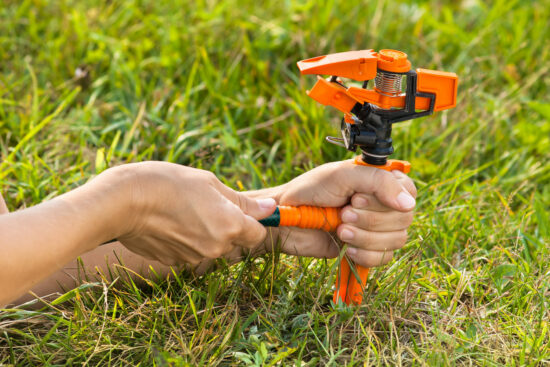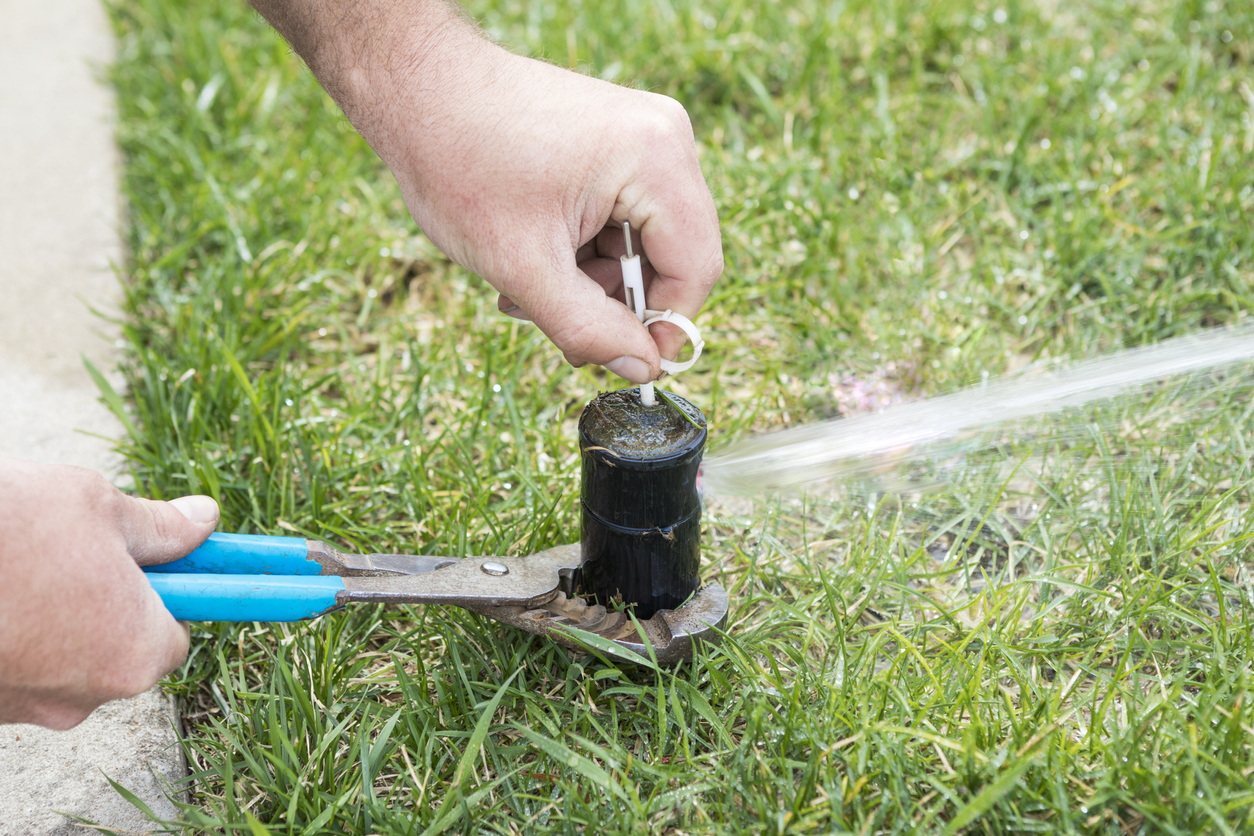Your sprinkler system helps you maintain a lush green lawn and healthy garden during the growing seasons. Before the first freeze arrives, it’s essential to learn how to winterize your sprinkler system or call in a technician to take care of the job for you. While many professional landscaping companies can manage this job for a fee, it’s a task you can complete yourself with the right tools and knowledge. When you prepare your landscaping tools for winter, it’s time to winterize your sprinkler system, too. Follow this handy guide to learn how to winterize a sprinkler system.
Supplies for Winterizing Your Sprinklers
Depending on the method you use and the type of sprinkler system you own, you’ll need certain tools to successfully winterize your sprinkler system. It’s essential to always make safety a priority and use the right tools to avoid damage to your sprinkler system. Gather these supplies before you decide how to winterize your sprinkler system.
- Safety Glasses
- Pliers
- Foam Insulating Tape
- Foam Pipe Covers
- Air Compressor
How to Winterize a Sprinkler System: Your Step-by-Step Guide to Three Common Methods
The method you choose for how to winterize a sprinkler system depends on the type of system you own. If you’re not sure what type of sprinkler system you have, then contact a professional to come to your property for an inspection.
The three most common processes are:
- Draining manual valves
- Draining automatic valves
- Sprinkler blowout
Once you know what type you have, use one of these methods to winterize your sprinkler system:
How to Winterize a Sprinkler System With Manual Drain Valves
Some irrigation systems use manual valves to eliminate water from the system. These systems work by opening valves that are located at the lowest end of the system. If your sprinkler has manual valves, then follow these steps for winterization:
- Shut off the supply of water to the system. If your system also has a backflow preventer, turn it off, too.
- Locate the manual valves located at the low points and ends of the piping.
- Open all the valves and drain all water from the system.
- If your system has check valves (which are designed to allow water to go only one way), then raise your sprinkler heads to let water drain from the valves.
- To ensure all water is drained between the shut-off valve and backflow device, your system may have a boiler drain valve or a stop and waste valve. Open the drain cap and open this valve to drain the remaining water from the system.
- When all water has drained from the system, close all the manual valves.
How to Drain Water From a Sprinkler System With Automatic Drain Valves
Sprinkler systems with automatic valves are designed to dispel water if the pressure falls below a certain point. This type of system makes draining a little easier, but you’ll still need to manually drain water from the valves. Take these steps to drain water from your sprinkler system with automatic valves:
- Turn off all water to the system.
- Run one of the sprinkler heads to release water pressure from the system.
- To release the water trapped in the valves, locate the valve solenoid on each valve and manually loosen them. This will allow air to flow inside the system and allow water to drain into the mainline.
- Drain any remaining water between the shut-off valve and backflow device by locating the boiler drain valve or stop and waste valve. Open the drain cap and loosen the valve to drain all water left in the system.
The Blow-Out Method of How to Winterize a Sprinkler System
This method uses compressed air to blow moisture out of the system. This is usually a final step taken after draining is complete for either type of sprinkler system. It’s important to note that a blow-out is often completed by a professional to ensure all water is removed from the system. If you have an air compressor with a cubic foot per minute (CFM) rating of 80 to 100, it is possible to complete a sprinkler system blowout yourself.
Pro Tip for How to Winterize a Sprinkler System:
Using compressed air can be dangerous and result in significant injury. If you’re planning a DIY sprinkler system blow-out, then wear eye protection throughout the process and avoid standing over pipes, sprinklers, and valves. But if you aren’t accustomed to using an air compressor or you’re not sure if yours is properly rated, then leave this step to the professionals.
Learning how to winterize a sprinkler system with an air compressor involves a specific process you must follow carefully. To complete a DIY sprinkler system blow-out, follow these steps:
- If you haven’t manually drained the water from your system, then turn off the water supply to the system.
- With the air compressor valve in the closed position, attach the air hose to the coupling that fits your system.
- Locate the valve furthest from the compressor and at the highest point and turn it on.
- Close the backflow valves.
- Slowly open the valve on the air compressor. Add air gradually, ensuring you never exceed the recommended pressure for the lowest pressure rated component on the zone, and never exceed 80 PSI.
- Stop the airflow and close the valve when the spray of water stops.
- Work your way through the system by completing the blow-out process on each valve. Start with the furthest valve, and finish with the valve closest to the air compressor.
- After completely draining all the valves, disconnect the air compressor and release any pressure left in the system.
- Open and close the valves on the backflow device to eliminate air pressure from the backflow device.
Complete the Winterization Process
After the water is completely drained from your system, it’s important to protect the components of your sprinkler system that will be exposed to freezing temperatures. Follow these final steps of how to winterize your sprinkler system’s exposed parts.
Insulate Above-Ground Components
Any exposed parts of your sprinkler system, including pipes, backflow preventers, and main shut off valves, should be insulated against freezing temperatures. Without blocking drainage ports or valves, use foam insulating tape and pipe covers to protect working parts against freezing and cracking.
Check Your Owner’s Manual for Specific Instructions
Some sprinkler systems require that you store some removable parts indoors during freezing weather. Consult your manual to learn if you should disconnect the valves and cap off pipes for the winter.
After That, Turn off Your Programmable Timer
If your system is on a timer, then you’ll need to shut it off for the winter and reprogram it in the spring. Alternatively, if your system has a rain mode, then you can use it to override the sprinklers without losing your programmed settings.
How Much Does It Cost to Have My Sprinkler System Professionally Winterized?
The cost to have your system winterized professionally typically ranges from $40 to over $200, with a national average of $81. It’s important to remember that this cost likely comes with a guarantee your system will be protected against freezing for the winter. You might be able to get a discount from a local professional servicing several yards in the same area.
You can expect a professional winterization to include:
- Shutting off the main water supply
- Draining the backflow preventer
- Completely draining or blowing out of all water in the system
- Removal of the fertilizer or rust-blocker injection system
- Shutdown of the timing system
If you need assistance reprogramming your system next spring, then you may face an additional fee.
If you don’t understand how to winterize a sprinkler system yourself, calling a professional is essential to keeping your sprinkler system in working order. The cost of having your sprinkler system winterized is only a fraction of the price of potential repairs if parts of your system are damaged due to freezing weather.
Winterizing your lawn sprinkler system will help you avoid damage from water freezing within the system, and it’s an essential part of winterizing your home. Protecting the working parts of your sprinkler system can help you avoid the cost of additional repairs. It can also extend the life of your sprinkler system. Once you learn how to winterize a sprinkler system yourself, it’s a task you can easily take care of each year.








